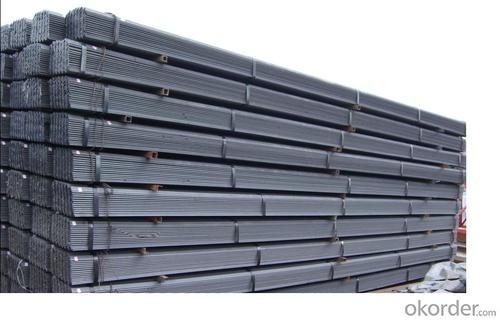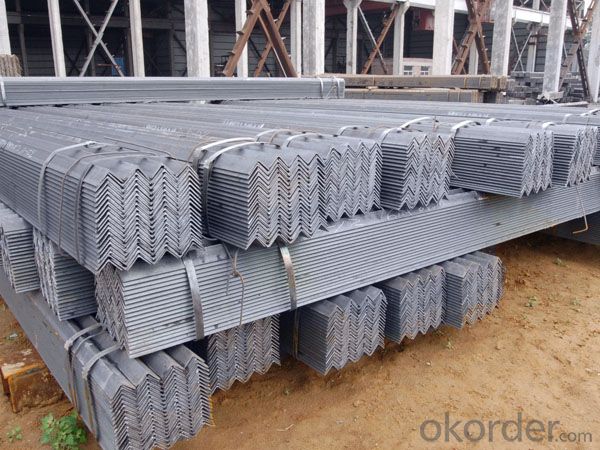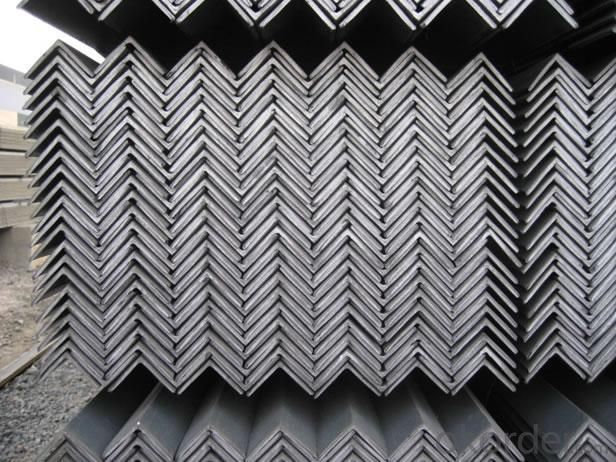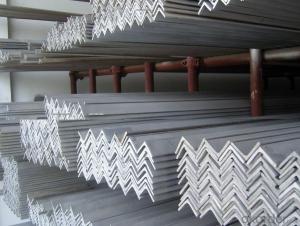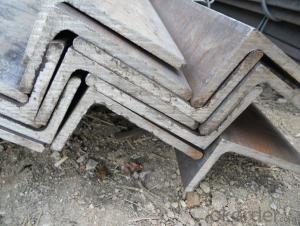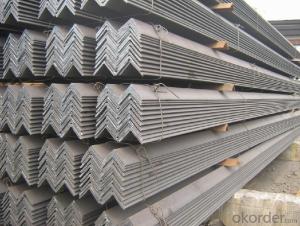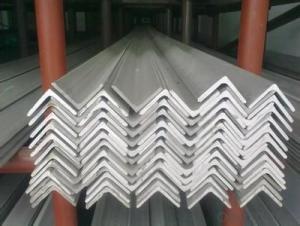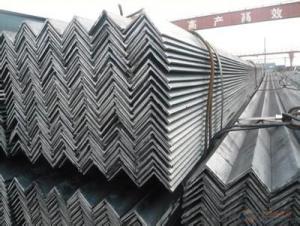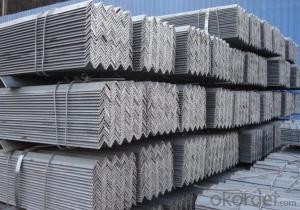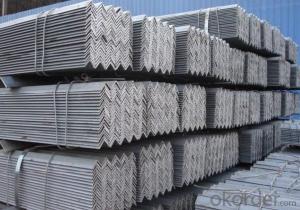Hot rolled angle steel GB Q235 or Q345B or equivalent
- Loading Port:
- Tianjin
- Payment Terms:
- TT OR LC
- Min Order Qty:
- 25 m.t.
- Supply Capability:
- 20000000 m.t./month
OKorder Service Pledge
OKorder Financial Service
You Might Also Like
Product Description:
Specifications
angle steel
1.size:25*16*3mm-200*125*18mm
2.quality:Q235,Q345,SS400,A36
3.length: 6m, 9m, 12m
4.unequal
angle steel
angle steel
(1)Material:Q235 SS400 S235JR OR ST37-2 Q345
(2)Size:25x16x3mm-200x125x18mm
(3)Certificate:ISO,CE
agle steel
angle steel
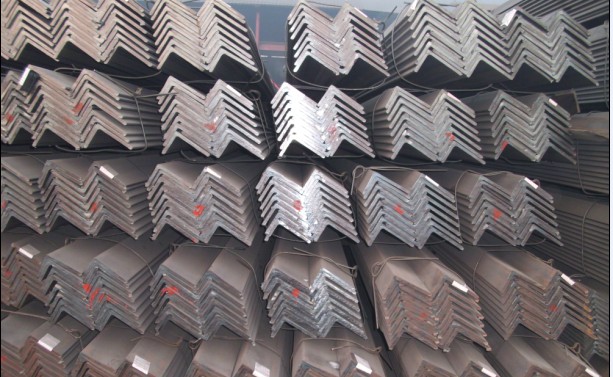
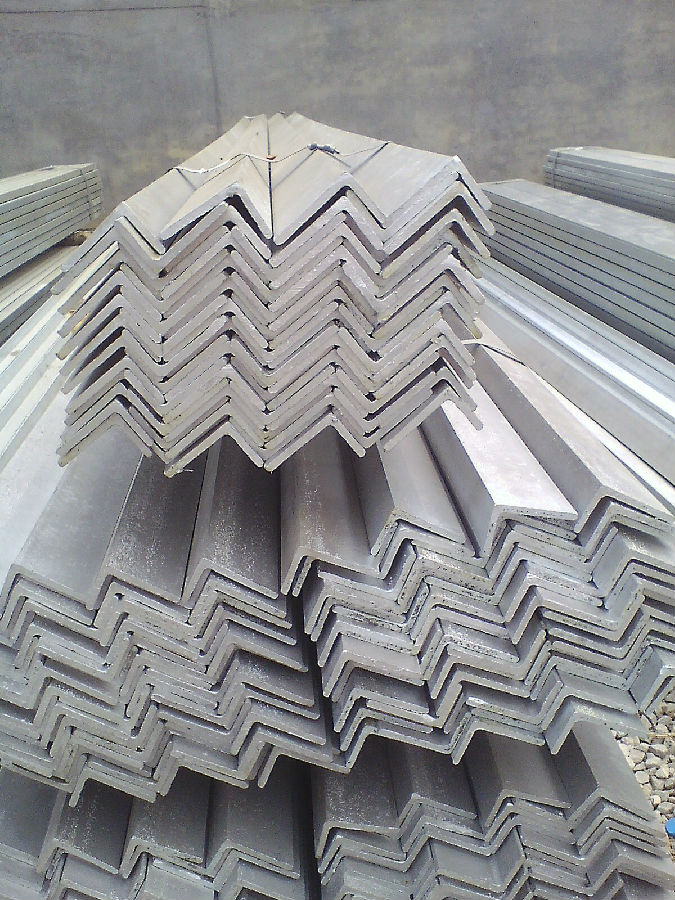
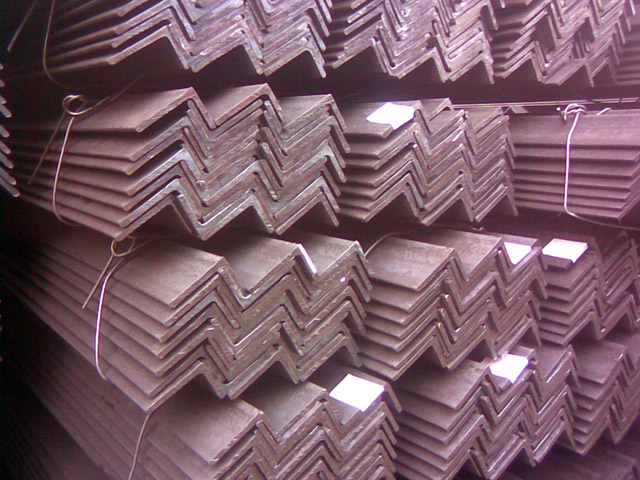
Angle called angle, the steel strip is perpendicular to each other on both sides into angular.Divided into equilateral angle steel and ranging from side angle. Two equilateral angle steel edge width is the same. The specification is expressed by edge width * width * thick edgenumber of millimeters. Such as "/ 30 x 30 x 3", namely that equilateral angle steel edge widthof 30 mm, 3 mm thick edge. Can also be used to model representation, model is the wideangle 3# cm, such as. The model does not represent the same type in different edge thickness size, thus in the contract and other documents on the angle of the edge width, edgethick size fill in complete, avoid alone represented by type. Hot rolled equilateral angle steelspecifications for 2#-20#. Angle according to the different needs of structure composed of a variety of stress components, can also be used as a component of the connections between the. Widely used in a variety of architectural and engineering structures, such as beams,bridges, towers, hoisting and conveying machinery, ships, industrial furnace, reactor,container frame and warehouse.
Mainly divided into equilateral angle steel, equilateral angle steel two categories, includingunequal angle can be divided into equal thickness and unequal thickness ranging from two.
Angle specifications with the side length of the size and edge thickness. At present, the domestic steel specifications for 2 - 20 cm in length, number of numbers, the same horn steel often have 2 - 7 different edge thickness. The actual size and inlet angle marked on both sides of the thickness and indicate the relevant standards. The general length of more than 12.5cm for large angle steel, 12.5cm - 5cm for the medium angle, length of 5cm for smallangle.
Inlet and outlet angle steel orders generally required the use specifications in the steel,carbon structural steel grades as appropriate. Is the angle in addition to standard number, nospecific composition and performance series.
Angle steel delivery length is divided into fixed length, size two, domestic steel length range is3 - 9m, 4 12M, 4 19m, 6 19m four range according to different specifications. Japanese steellength ranges from 6 to 15m.
Section of unequal angle height according to the long edge of the width to calculate the non equilateral angle steel. Refer to section angle and side length is not equal to the steel. Is a kind of angle steel. The length from 25mm * 16mm to 200mm * l25mm. By the hot rolling mill rolling in. General scalene angle steel specifications: thickness of 4-18mm / 50*32-- / 200*125
Equilateral angle steel is widely used in all kinds of metal structures, bridges, machinery manufacturing and shipbuilding industry, all kinds of architectural and engineering structures,such as beams, bridges, towers, hoisting and conveying machinery, ships, industrial furnace,reactor, container frame and warehouse etc.
1.Transportation: the goods are delivered by truck from mill to loading port, the maximum quantity can be loaded is around 40MTs by each truck. If the order quantity cannot reach the full truck loaded, the transportation cost per ton will be little higher than full load.
2.With bundles and load in 20 feet/40 feet container, or by bulk cargo, also we could do as customer's request.
3. Marks:
Color mark: There will be color marking on both end of the bundle for the cargo delivered by bulk vessel. That makes it easily to distinguish at the destination port.
Tag mark: There will be tag mark tied up on the bundles. The information usually including supplier logo and name, product name, made in China, shipping marks and other information request by the customer.
If loading by container the marking is not needed, but we will prepare it as customer request.
- Q: How do steel angles perform under vibration or resonance conditions?
- Steel angles are generally stable and perform well under vibration or resonance conditions. Due to their rigid structure and strong material properties, steel angles have a high resistance to vibrations and can effectively dampen resonance effects. This makes them suitable for various applications where stability and durability are required, such as in construction and engineering projects.
- Q: Can steel angles be used in earthquake-resistant building designs?
- Indeed, earthquake-resistant building designs can incorporate the usage of steel angles. Steel, renowned for its exceptional strength and ductility, proves to be a suitable material for constructing earthquake-resistant structures. In various applications, steel angles, also referred to as L-shaped steel sections, can be employed to provide structural support and reinforcement. One of the primary benefits of incorporating steel angles into earthquake-resistant building designs lies in their capacity to withstand lateral loads and shear forces. The L-shape of these steel angles establishes a robust and stable connection between distinct structural components, effectively distributing and transferring loads during seismic events. Consequently, this aids in mitigating structural deformation and averting collapse. Additionally, the fabrication and installation of steel angles are exceptionally convenient, rendering them a favorable choice for earthquake-resistant designs. These angles can be welded, bolted, or riveted to other steel elements, ensuring a sturdy and dependable connection. Furthermore, customization options are available, allowing for structural configurations to be tailored to meet specific design requirements. Furthermore, steel angles exhibit commendable fire resistance properties, a crucial aspect to consider in earthquake-resistant designs. Compared to other building materials, steel retains its structural integrity for an extended period in the event of a fire, thereby reducing the risk of collapse during rescue operations. To conclude, it is evident that steel angles can indeed be utilized in earthquake-resistant building designs. Their exceptional strength, ductility, and capability to withstand lateral loads make them an invaluable component in structural systems. By implementing appropriate design and installation techniques, steel angles can enhance the overall resilience and safety of buildings situated in earthquake-prone areas.
- Q: Can steel angles be used for support brackets in electrical installations?
- Yes, steel angles can be used for support brackets in electrical installations. Steel angles are commonly used in construction and can provide sturdy support for various applications, including electrical installations. They are strong, durable, and can withstand the weight and stress associated with supporting electrical components or fixtures. Steel angles can be easily mounted to walls, ceilings, or other surfaces, providing a stable base for electrical equipment such as junction boxes, conduit, or cable trays. Additionally, steel angles can be customized and fabricated to meet specific installation requirements, making them a versatile choice for support brackets in electrical installations.
- Q: How do steel angles perform in extreme temperatures?
- Steel angles are renowned for their exceptional performance in extreme temperatures. With their high melting point, they possess the ability to endure both exceedingly high and low temperatures without compromising their structural integrity. When faced with intense heat, steel angles display a remarkable resistance to thermal expansion, thereby preserving their form and strength. Similarly, even in extremely cold conditions, steel angles remain resilient and impervious to brittleness or weakness, ensuring their longevity and dependability. Consequently, steel angles are highly suitable for use in industries such as construction, automotive, and aerospace, where they are frequently subjected to a wide range of temperature variations. Furthermore, steel angles exhibit exceptional fire resistance, further augmenting their effectiveness in extreme temperature scenarios. All in all, when it comes to applications necessitating stability and strength in extreme temperatures, steel angles are the preferred choice.
- Q: How do steel angles perform in high-temperature environments?
- The inherent properties of steel angles make them highly effective in high-temperature environments. Steel is renowned for its ability to withstand elevated temperatures without significant structural degradation, thanks to its high melting point and thermal conductivity. This means that steel angles maintain their strength and stability, making them suitable for a wide range of applications. A key factor contributing to the exceptional performance of steel angles in high-temperature environments is their structural integrity. Steel has a high melting point, typically between 1300 and 1500 degrees Celsius, depending on the specific grade. This ensures that steel angles retain their shape even in extreme heat conditions, providing durability and reliability. Furthermore, steel's low coefficient of thermal expansion minimizes expansion and contraction when exposed to temperature changes. This is crucial in high-temperature environments as it reduces the risk of warping or distortion of steel angles. The dimensional stability of steel angles enables them to withstand thermal cycling without compromising their structural strength. Moreover, steel exhibits excellent thermal conductivity, enabling efficient heat dissipation. This prevents the accumulation of excessive heat in steel angles, reducing the risk of thermal stress or failure. By effectively transferring heat away from critical components, steel angles increase their durability and longevity in high-temperature environments. Additionally, steel angles can be further enhanced with heat-resistant coatings or treatments. These coatings provide an extra layer of protection against oxidation, corrosion, and thermal degradation, enhancing the resilience of steel angles in extreme heat conditions. To summarize, steel angles are an ideal choice for high-temperature environments due to their high melting point, low thermal expansion, excellent thermal conductivity, and the possibility of additional heat-resistant coatings. Their ability to maintain structural integrity, dimensional stability, and efficient heat dissipation makes them a reliable solution for various applications where exposure to elevated temperatures is a concern.
- Q: What is the thickness of the national standard 8# angle steel? Thank you
- Composition index: the chemical composition of angle iron is a series of rolled steel products for general structure, and the main verification indexes are C, Mn, P and S four items. According to different grades, the content of each difference, the approximate range of C<0.22%, Mn:0.30-0.65%, P<0.060%, S<0.060%.
- Q: How do you transport and ship steel angles?
- Transporting and shipping steel angles require careful planning and proper handling to ensure their safe and efficient delivery. Here are some key steps involved in the transportation and shipping process: 1. Packaging: Steel angles should be properly packaged to prevent damage during transit. They are often bundled together using steel bands or placed on pallets to keep them secure and stable. 2. Size and weight considerations: Before shipping, it is important to consider the size and weight of the steel angles. This information is crucial for determining the appropriate mode of transportation and selecting the right shipping containers or vehicles. 3. Mode of transportation: Steel angles can be transported by various means, including trucks, trains, ships, or planes. The choice of transportation mode depends on factors such as distance, urgency, and cost. For domestic shipments, trucks or trains are commonly used, while for international shipments, ships or planes are preferred. 4. Loading and securing: Proper loading and securing of steel angles are essential to prevent any movement or damage during transit. They should be loaded onto transportation vehicles using appropriate lifting equipment, ensuring that they are evenly distributed and properly secured to prevent shifting or falling. 5. Insurance and documentation: It is advisable to obtain appropriate insurance coverage for the steel angles during transportation to protect against any unforeseen circumstances. Additionally, proper documentation, including bills of lading, shipping labels, and customs paperwork, should be prepared and attached to the shipment to facilitate smooth transit and customs clearance. 6. Compliance with regulations: When shipping steel angles, it is important to comply with all relevant regulations and requirements. This includes adhering to weight restrictions, securing necessary permits or licenses, and following any special handling or safety guidelines. 7. Tracking and monitoring: Throughout the transportation and shipping process, it is crucial to have effective tracking and monitoring systems in place. This allows for real-time visibility of the shipment's location, ensuring timely delivery and prompt intervention in case of any issues or delays. By following these steps and working with experienced logistics partners, you can ensure that steel angles are transported and shipped safely and efficiently, minimizing the risk of damage or delays.
- Q: How do steel angles contribute to the stability of a structure?
- Steel angles contribute to the stability of a structure in several ways. First and foremost, steel angles are commonly used as structural members in various applications such as buildings, bridges, and towers. They provide strength and stability to the overall structure. The unique shape of steel angles, with one side longer than the other, allows them to resist both compression and tension forces, making them perfect for carrying heavy loads. Furthermore, steel angles are often used to create rigid connections between different structural components. By welding or bolting steel angles at critical joints, they help distribute the load evenly and prevent excessive movement or deformation. This enhances the overall stability and integrity of the structure, especially during dynamic loads such as wind or seismic forces. In addition, steel angles can also be utilized as bracing elements. Bracing is crucial for resisting lateral forces like wind or earthquake loads. By strategically placing steel angles diagonally between structural members, they create a triangulated system that improves the overall stability of the structure. This bracing helps prevent excessive sway or deflection, ensuring the structure remains rigid and secure. Moreover, steel angles are highly durable and resistant to corrosion, which is essential for the long-term stability of a structure. They can withstand harsh environmental conditions, including exposure to moisture, UV radiation, and temperature fluctuations. This durability ensures that steel angles maintain their structural integrity over time, providing ongoing stability and safety. Overall, steel angles play a vital role in ensuring the stability of a structure. Their ability to resist both compression and tension forces, create rigid connections, act as bracing elements, and their durability make them indispensable in various construction projects. By incorporating steel angles in the design and construction process, engineers can enhance the stability, strength, and safety of the structure, ultimately providing a reliable and long-lasting solution.
- Q: Can steel angles be used for agricultural buildings or barns?
- Indeed, agricultural buildings or barns can employ steel angles. The prevailing usage of steel angles in construction is attributed to their robustness and endurance. Specifically, they prove invaluable in agricultural buildings or barns, where the structure must endure substantial burdens and adverse weather conditions. Steel angles can be employed in the framing, bracing, and reinforcement of diverse building constituents, including walls, roofs, and doors. Furthermore, steel angles can be readily fabricated and tailored to fulfill precise design specifications, rendering them a multifaceted option for agricultural buildings or barns.
- Q: What is the maximum deflection allowed for steel angles?
- The maximum deflection allowed for steel angles depends on several factors such as the specific application, the load applied, and the design standards being followed. Generally, the maximum deflection for steel angles is determined by considering the acceptable level of aesthetic appearance and structural performance. Consulting the relevant design codes or consulting with a structural engineer would provide more specific information on the maximum allowable deflection for steel angles in a given situation.
Send your message to us
Hot rolled angle steel GB Q235 or Q345B or equivalent
- Loading Port:
- Tianjin
- Payment Terms:
- TT OR LC
- Min Order Qty:
- 25 m.t.
- Supply Capability:
- 20000000 m.t./month
OKorder Service Pledge
OKorder Financial Service
Similar products
Hot products
Hot Searches
Related keywords



